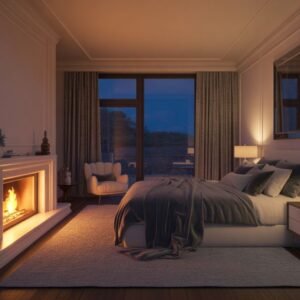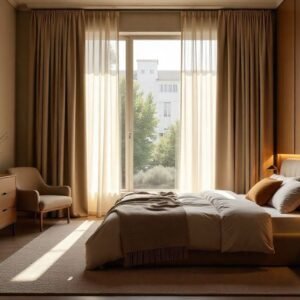A home bar may sound old fashioned, but you know it’s still that quiet place where design and relaxation meet, where conversations slow down. It can be as simple as a small cabinet built into the wall of the living room or as fancy as a separate room for watching TV. Home bar furniture not only gives you a place to store things, but it also adds character and warmth to your beautiful home.
To most people, it is a mirror of personality. To others, it is a declaration of ease and artistry. A sound bar is not merely a place to store your bottles; it is a place that makes you feel alive, where light, texture, and proportions all combine in harmony. What makes home bar furniture so defining in the present-day homes? Let us subdivide this.
The Modern Take on Home Bar Furniture Design
The home bar furniture design has taken a very different shape. The massive, over-decorative items that dominated family parlours are a thing of the past. The current demand among homeowners and designers is for furniture that fits well with the available interior, is stylish, space-saving, and practical.
It is the attraction of flexibility. In small apartments, fold-away bar cabinets or wall shelves can serve as both decor and storage. In bigger houses, a built-in bar with high stools, mood lights, and built-in cabinetry should be an element of sight, a feature that would attract one.
The balance between openness and discretion is also stressed in modern furniture design. Bottles, glasses, and accessories are available to display or hide as you see fit. Minimalist figures and textural effects-matte wood, brushed brass, tinted Glass, etc. give the room three-dimensionality without fecundity.
Also read: Bedroom Wall Decor: Raising Your own Haven
And then again, there is craftsmanship. The most effective home bar setups are those made from materials that not only look good but also age well. Consider walnut wood, smooth stone, or a laminate finish that looks more like a natural finish but is easier to maintain.
How Design Shapes the Experience

When we talk about the design of home bar furniture, we are referring to the experience it produces. A bar is a social venue; it is supposed to foster socializing, comfort, and coziness. Aspects such as shelf location and lighting type add to the experience.
Start with the layout. The traffic between the bar and the rest of the area must be natural. When the bar is placed close to a living or dining room, it should match the furniture and lighting in that room.
Next, focus on light. The mood can be entirely changed with soft, indirect lighting, either via pendant lamps or concealed LEDs. It underlines the materials, creates a sense of self-proximity, and does not overwhelm the room.
And don’t overlook sound. The most perfectly designed bars are musically agreeable. They do not echo and adopt noise-absorbing materials, such as upholstery, carpeting, and rough walls. All these combine to provide a relaxing atmosphere which encourages lingering.
Exploring Different Home Bar Designs
The number of home bar designs currently offered provides consumers with creative choices to suit the space and their lifestyle. Others like smooth, contemporary bars that are more or less sculptural in their appearance: geometric shelves, mirrored doors, and a touch of metallic. Others incline toward a warm, organic style with natural wood colors, rattan, or stone-cold tops.
Small designs are particularly suited to what one would want in an apartment. A corner unit or floating shelf setup could be small and fit easily in the room without crowding it. Put in some accent lights and a work of wall art, and you have your own focal point.
When there is space, consider a counter-height bar with stools. It invites discussion by its nature. Combine textures: metal is polished at the bottom of the footrest, wood is used to make it warm, and glass is used to make it clear. The optimal home bar furniture is both a spectacle and usable daily.
The Art of Designing a Home Bar
Home bar design involves a lot of mood-making rather than material materials. To begin with, specify the purpose. Do you use it as your personal getaway, or is it a guest house? The solution will inform your scale, light, and style.
Think about ergonomics too. The counter should be high enough to mix and serve comfortably, and storage should be convenient enough that it does not make a person feel confined. Arrange your design so that everything is in its place, bottles, mixers, bar tools, or glasses, but nothing looks imposed.
Colors make a significant impact. Dark shades of charcoal, navy, or forest green are rich and complemented well by brass or gold ornaments. Light colors, however, make small areas feel airy and open.
And most importantly, there is the issue of personalization. Hang old bar signs, keep a carefully curated collection of bottles, use open shelving, whatever you wish, make it yours. The aim of home bar design is not to look like a restaurant but to be an extension of your lifestyle, a style that shows your character when the day slows down.
Choosing the Right Bar Designs for Home
When deciding what to include in the design of a bar in the house, one should remember that size alone does not determine how sophisticated it should be. Even a well-placed cabinet will be purposeful if planned carefully. Proportion, balance, and flow are of greater importance.
In-built bars suit the open spaces perfectly; they appear smooth and integrated. In the meantime, flexibility is brought by portable trolleys or standalone cabinets. You can relocate them, put together the meeting design, and make the space lively.
Pay attention to finishes. A modern touch is given by matte black metal. Rich wood tones bring warmth. Mirrored backs or glass shelves help to make it more dimensional. And concrete surfaces, stone, laminate, or wood grain give the space a tactile quality that subtly contributes to the environment.
Finally, the home bar designs are an art statement without being overly obtrusive. They will be an inorganic part of the bigger design language of your interiors.
Material Matters: Quality in Every Detail
Materials are very crucial to the longevity and appeal of home bar furniture. Although natural wood and stone are eternal, engineered wood and stone have come a long way in providing durability and diversity. Examples of such laminates include marble or walnut, but they are easier to clean and less susceptible to moisture, making them a good choice in areas prone to spills.
In appropriate applications, metal fixtures are strong and have a high-end look. The ageing of brass, chrome, and matte steel all give the structure character over time. Glass applied to the doors of the cabinets or shelves makes the structure appear lighter and reflects light well throughout the room.
Each surface, joint, and texture speaks. The tactile experience adds the sense of quality: the smoothness of a countertop, the subtle feel of wood, and the coolness of metal. Good materials do not assist in design; they determine it.
How Interiors Collective Approaches Design
At Interiors Collective, it is not about adding more to design, but refining what is already there. Each item and design is an opportunity to enhance everyday life. Their approach to space, whether in the kitchen, bedrooms, or living rooms, is also more about human experience than visual harmony.
Their design philosophy provides a cerebral framework for those considering home bar furnishings: classic rather than frivolous, impeccable rather than ornamental, and cozy rather than luxurious. It is to turn design into an invisible art, that is, something that improves the way you live in an unspoken manner.
Conclusion
A bar at home does not have to be fancy to be special. The point is in the intent of its design. When home bar furniture is carefully selected for its proportions, textures, and atmosphere, it ceases to be a mere functional arrangement and becomes a significant part of your home.
Finally, good design does not have to scream to get attention; it just works.
FAQs
Engineered wood, laminate, metal, and glass are great options. They offer a trade off between the durability & design versatility and not even very difficult to maintain.
Choose small furniture or wall mounted pieces, vertical storage, and layered lighting. Even the smallest corner of the room could be meaningful with the help of a foldable counter or a hidden cabinet.
Be consistent in terms of selecting the color tones, textures, and finishes. Always select materials & designs that match your existing style, rather than those that contrast with it.





